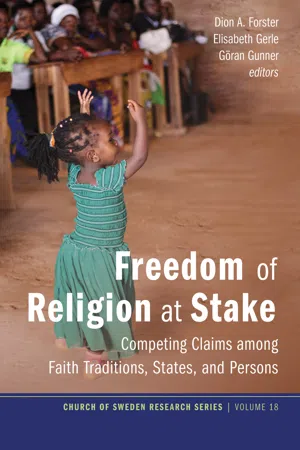![]()
Part I
Freedom of Religion in Different Settings
![]()
1
Religiosity in South Africa and Sweden
A Comparison
Hennie Kotzé
Many influential social thinkers in the nineteenth century—such as Auguste Comte, Herbert Spencer, Emile Durkheim, Max Weber, and Karl Marx—predicted that religion would slowly weaken and that its importance in many people’s lives would disappear. As Norris and Inglehart pointed out: “The death of religion was the conventional wisdom in the social sciences during most of the twentieth century.” In this period, levels of secularization—that is “a systematic erosion of religious practices, values, and beliefs”—will rise and religiosity will fade away in the face of industrialization.
Furthermore, as Norris and Inglehart noted, with the prediction of the “death of religion” and, later in the twentieth century, the growing support for theories of secularization, it was always difficult to provide watertight explanations for the fading of religion. However, as it turned out, the prediction of its demise was premature. More recently, as societies become more industrialized, “demand side” theories, which stressed the gradual dwindling of religious beliefs and habits, became acceptable in certain circles as explanations for the erosion of religiosity. On the other hand “supply side,” or top-down theories, stress that there will always be a demand for religion; thus, “If you build a church, people will follow.”
Norris and Inglehart’s book, Sacred and Secular, in which they make extensive use of the research on changing values on a global level, forms the basis for this chapter’s comparison of levels of religiosity between Sweden and South Africa. They stress that their alternative theory of secularization based on conditions of existential security, is to a certain extent based on the demand-side theoretical perspective.
One of the most important arguments explaining this misreading of religious decline as presented in secularization was that most research in the past generally emphasized trends in church attendance by Protestants and Catholics in Europe. In fact, most surveys in post-industrialised nations indicated a steady decline in church attendance. This meant that the cross-cultural element in most of the reported research on the decline of religion was missing. Too many countries, especially those in the developing world were not initially included in the reported research. It is now clear that it would be a mistake to use, for instance, Western Europe to generalise for the whole world, while traditional religious views comprise maybe the largest percentage of the world’s population. One, therefore, not only needs to consider these differences but should also include these populations in your research.
Norris and Inglehart, in examining trends in secularization, suggested that the importance of religiosity “persists most strongly among vulnerable populations, especially those living in poorer nations, facing personal survival-threatening risks.” For them, an indication of the level of secularization in rich nations relates to their values and behavior concerning religion. Their version of secularization theory, based on existential security, rests on two axioms: (1) the security axiom, and (2) the cultural traditions axiom.
The two values case studies I used in this chapter to compare the level of religiosity, are Sweden and South Africa, while the analysis is based on the “vulnerability” theory of Norris and Inglehart. It firstly illustrates the differences in levels of poverty between the citizens of the two countries and then examines the differences in the values and behavior concerning religion in the two countries. I employ a “most different system” research design to the greatest amount of differences in levels of religiosity between the two nations. It is in the main thus, mainly a descriptive analysis.
To begin with, I will compare the level of vulnerability in terms of the two countries’ levels of mo...
